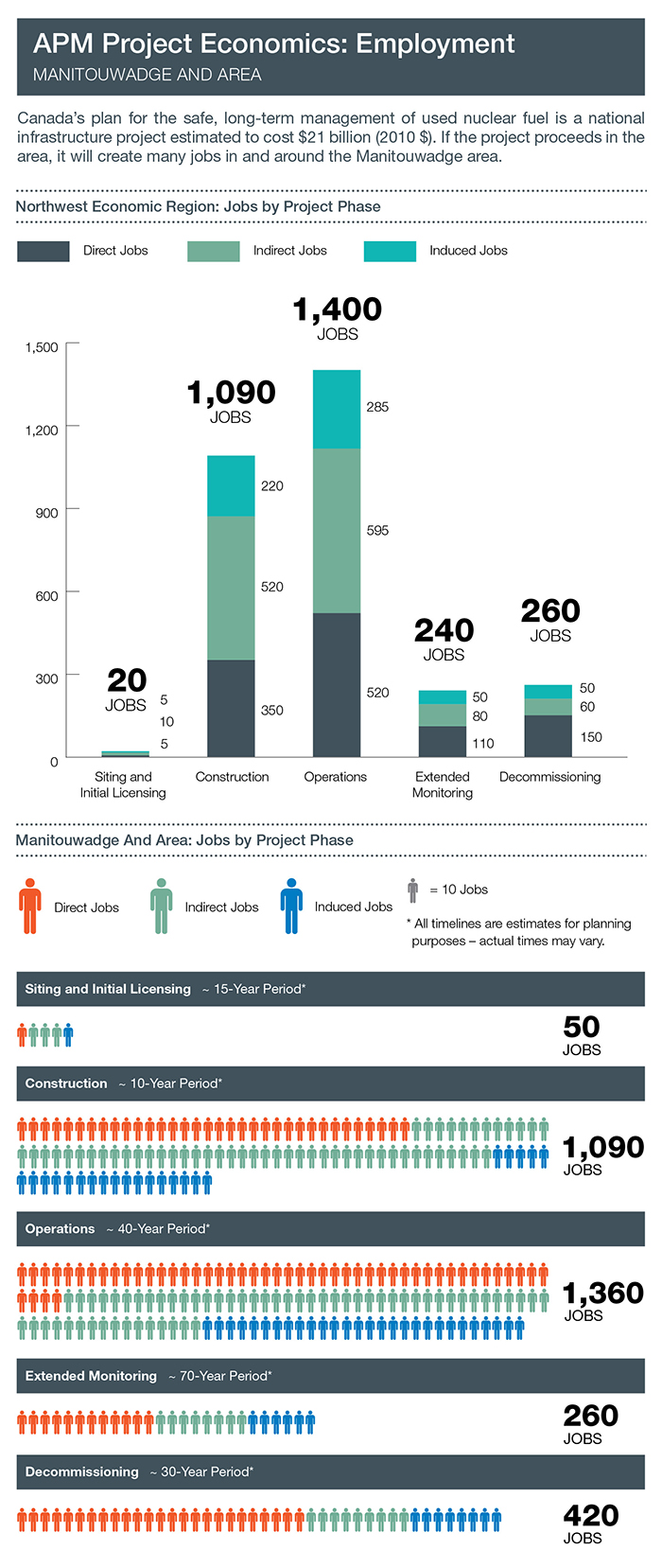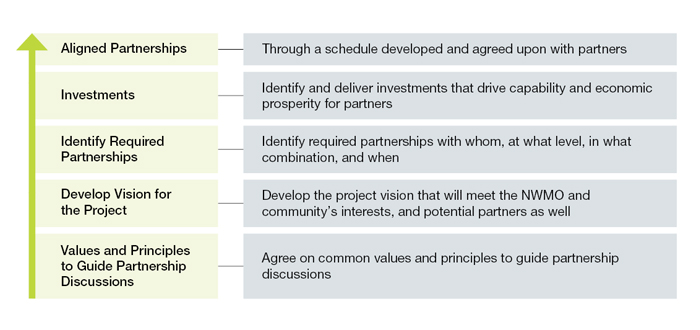Manitouwadge and area
Overview
In 2019, after several years of progressively more detailed study and engagement, we concluded that the community of Manitouwadge and area will not be considered a potential host for the project.
Canada's plan for the safe, long-term management of used nuclear fuel will only move forward in any area with interested communities, along with First Nation, Métis and surrounding communities, working together to implement it.
Information detailing work we completed in Manitouwadge and the surrounding area through steps one to three of the site selection process is available below.
Step 1: The NWMO Initiates the Process
The process began with a broad program to provide information, answer questions and build awareness about the project. Awareness-building activities are designed to continue throughout the site selection process.
In Step 1, we provided general information to those who requested it. We began assessment activities in Step 2: Initial Screening only after individual communities formally expressed an interest in learning more.
Step 2: Initial Screening
In September 2012, Manitouwadge's Mayor and Council passed a resolution requesting an initial screening of the community's potential suitability to host the project. This screening took us about three months to complete and involved a review based on readily available information about the geology of the community and vicinity. We encouraged communities that passed the initial screening to begin learning more about the project. We provided an initial briefing and invited representatives to take a tour of an interim storage facility for used nuclear fuel. We also encouraged communities to meet with the Canadian Nuclear Safety Commission to learn about the regulatory framework that will govern the project. Manitouwadge's initial screening was completed in January 2013. It did not identify any obvious conditions that would exclude the Manitouwadge area from further consideration in the site selection process.
Resources:
Step 3: Phase 1 - Desktop Studies and Engagement
In March 2013, Manitouwadge's Mayor and Council passed a resolution asking the NWMO to initiate a Preliminary Assessment of the community's potential suitability to host the project. In December 2014, we completed the first phase of Preliminary Assessment (Step 3: Phase 1) of the site selection process in collaboration with Manitouwadge. This phase involved: Desktop studies that explored the potential to find a site that can safely and securely contain and isolate used nuclear fuel; and Community learning and dialogue activities to build understanding about the project and to explore its potential to align with the community's long-term vision. Based on studies to date, the community appeared to have strong potential for meeting strict safety and geotechnical requirements, and for the project to align with its long-term vision. The studies also identified a number of uncertainties to be further explored through more detailed study.
Resources:
- Summary of January 2015 Phase 1 Decisions
- Integrated Preliminary Assessment Report
- Community Profile
- Phase 1 Geoscientific Desktop Preliminary Assessment of Potential Suitability for Siting a Deep Geological Repository
- Phase 1 Geoscientific Desktop Preliminary Assessment, Terrain and Remote Sensing Study
- Geoscientific Desktop Preliminary Assessment, Lineament Interpretation
- Geoscientific Desktop Preliminary Assessment, Processing and Interpretation of Geophysical Data
- Phase 1 Desktop Assessment, Environment Report
- Preliminary Community Well-Being Assessment
Step 3: Phase 2 - Field Studies and Engagement
In 2014, the NWMO began working with communities in this area to plan field studies and engagement as part of Preliminary Assessments. Through fieldwork, more detailed studies and broadened engagement, Phase 2 assessments expanded upon work completed earlier in the process.
Work in this phase began with initial studies such as geophysical and environmental surveys to further assess potential suitability.
Details from completed studies are published below.
- Phase 2 Preliminary Assessments: Summary findings and decisions based on advanced detailed studies
- Phase 2: Preliminary Environmental Studies: Summary Report - Township of Manitouwadge and Area
- Phase 2 Preliminary Assessment Potential for Partnership: Townships of Manitouwadge and Hornepayne and Area, Ontario
- Phase 2 Preliminary Assessments Summary Findings and Decisions Based on Initial Studies in Five Siting Areas
- Phase 2 Geoscientific Preliminary Assessment Initial Findings: Township of Manitouwadge and Area, Ontario
- Phase 2 Geoscientific Preliminary Assessment Acquisition, Processing and Interpretation of High-Resolution Airborne Geophysical Data: Township of Manitouwadge and Area, Ontario
- Phase 2 Geoscientific Preliminary Assessment Lineament Interpretation: Township of Manitouwadge and Area, Ontario
- Phase 2 Geoscientific Preliminary Assessment Geological Mapping: Township of Manitowadge and Area, Ontario
- Phase 2 Preliminary Assessment Potential for Partnership: Townships of Manitouwadge, Hornepayne and Area, Ontario
- Phase 2 Preliminary Environmental Studies: Township of Manitouwadge and Area, Ontario
- Phase 2 Preliminary Assessments in Crystalline Rock Settings: Working Together to Identify Study Areas
- Advancing the Site Selection Process: Identifying Areas for Sub-Surface Studies
Project Economics: Employment
To help understand the project's economic effects in potential siting areas, we developed models that provide initial estimates. By working together to implement the project, we can optimize and direct economic benefits to meet community expectations and needs.
We have committed to implementing the project in a way that fosters well-being as defined by the people who live in the area. We continue to learn from communities about the many dimensions of well-being that are important to them. Economics is just one aspect.
The project will create employment that includes:
Direct Jobs: Jobs at or near the repository site, including skilled and semi-skilled employment during construction and operations
Indirect Jobs: Jobs created by suppliers and contractors working on the project, such as food catering, accommodation, transportation, and equipment
Induced Jobs: Jobs created in retail and professional services by expenditures of people employed in direct and indirect jobs
Resources:
Exploring Partnerships
The NWMO and communities are beginning more detailed discussions on how to advance learning and build the sustainable partnerships that would be required to support the implementation of Canada’s plan for the safe, long-term management of used nuclear fuel.
The NWMO has outlined a multi-step road map to guide these partnership discussions, which focuses on exploring potential to advance the project in partnership with people in the area, as well as puts in place a framework to implement the project if a preferred site were identified in the area.
Road map to partnership (2017-2022)\
Manitouwadge and area identified values and principles to guide discussions with the NWMO to explore partnership and to consider the project in more detail. These values and principles, and the engagement activities that led to their development, are described in the summary report (Guiding principles for exploring partnership – Community conversations update) below.
Planning Initial Borehole Drilling and Testing
The focus of early geoscientific studies in the Manitouwadge area was to determine if there were rock formations in the area that had the potential to satisfy our safety requirements for a deep geological repository for the long-term management of Canada’s used nuclear fuel.
Geoscientific studies conducted to date have involved desktop studies, airborne geophysical surveys, observing general geological features, and detailed geological mapping. The next site evaluation activity in the area involved drilling a small number of initial boreholes in potential repository locations to further understand the geology. Assembling a permission application was one activity among many designed to help advance the NWMO's understanding of the perspectives of people in the area about the project. No boreholes were drilled, as the area was screened out of the site selection process.
Selecting locations for initial boreholes also provided an opportunity for the NWMO, the interested community, and First Nation and Métis communities in the area to work together to consider where the project might best fit.
Resources:
2019 Community Studies
In September 2019, the NWMO initiated community surveys in Manitouwadge to better understand and improve the way we communicate and engage with the public. The surveys were conducted by an independent Canadian research firm on behalf of the NWMO, and were designed to determine how communities would like to receive information during the site selection process.
Resources:


